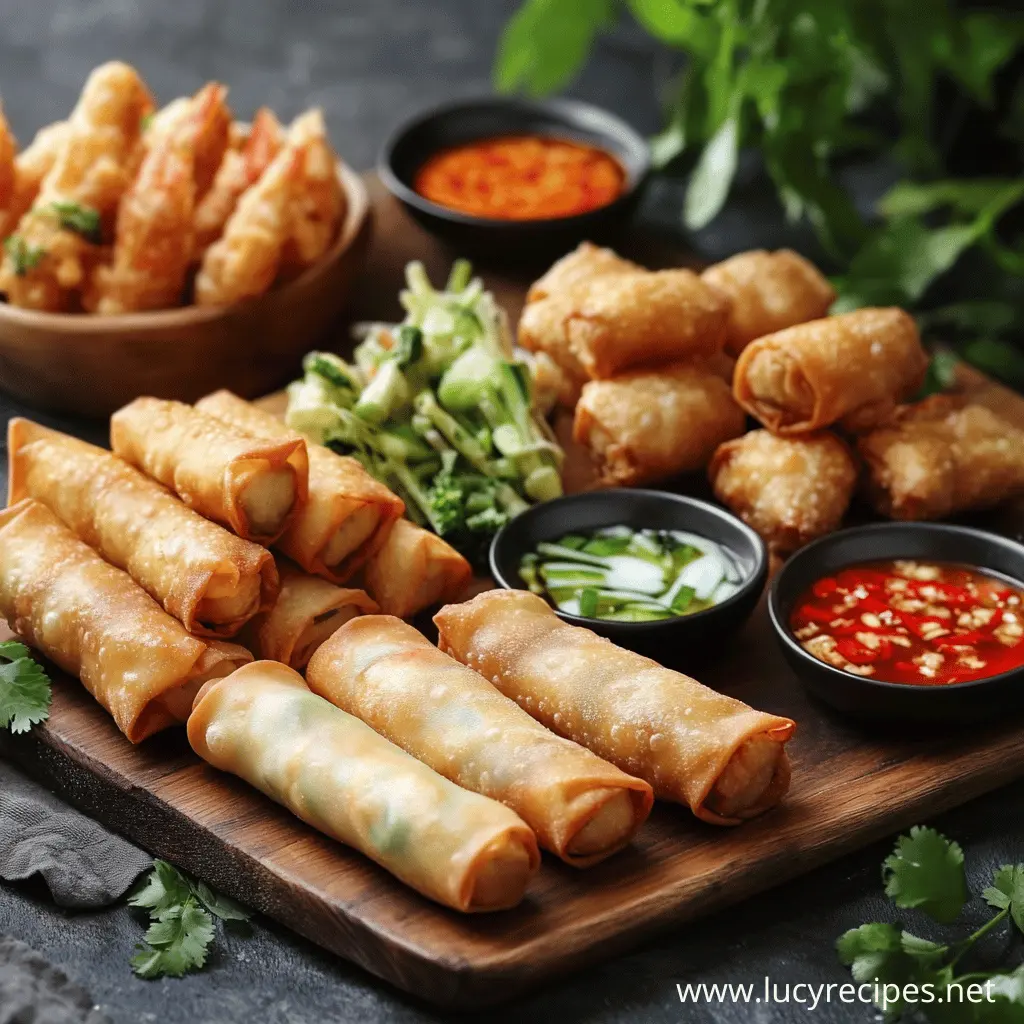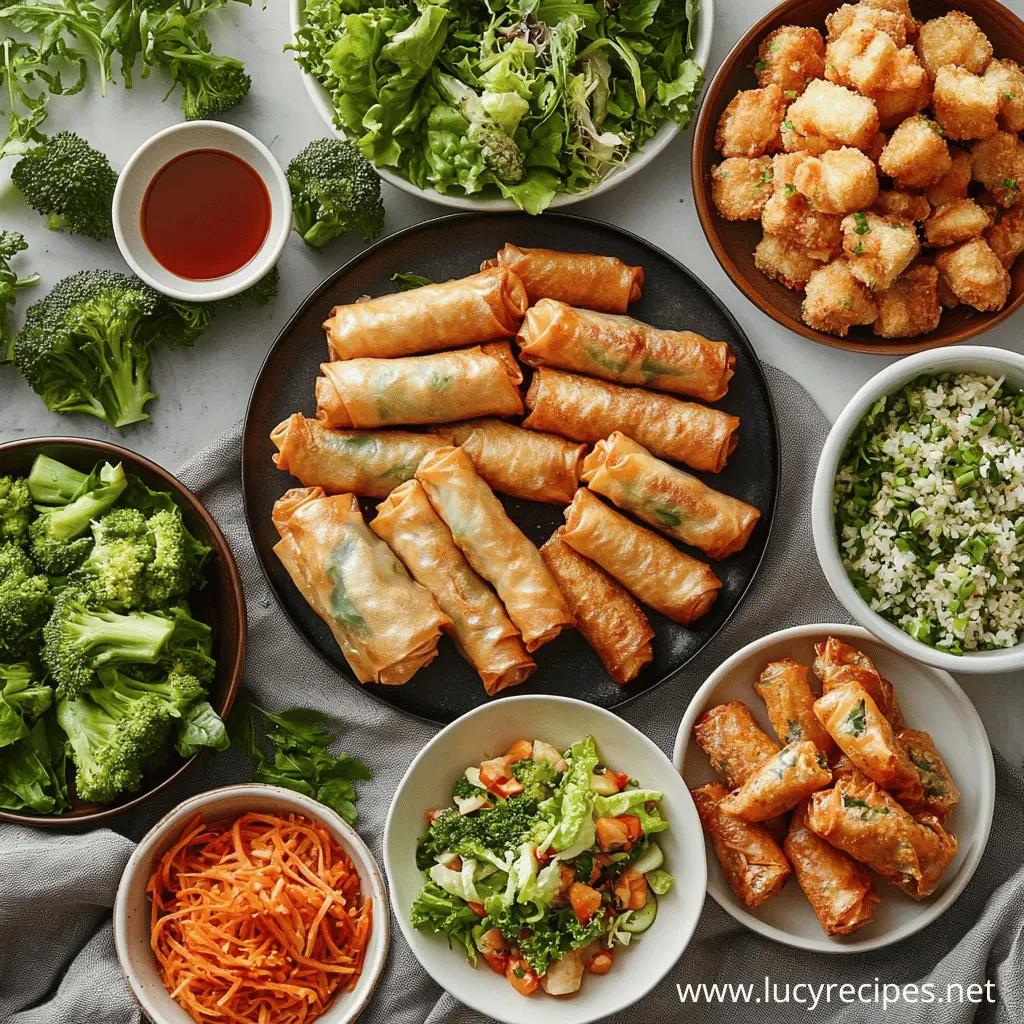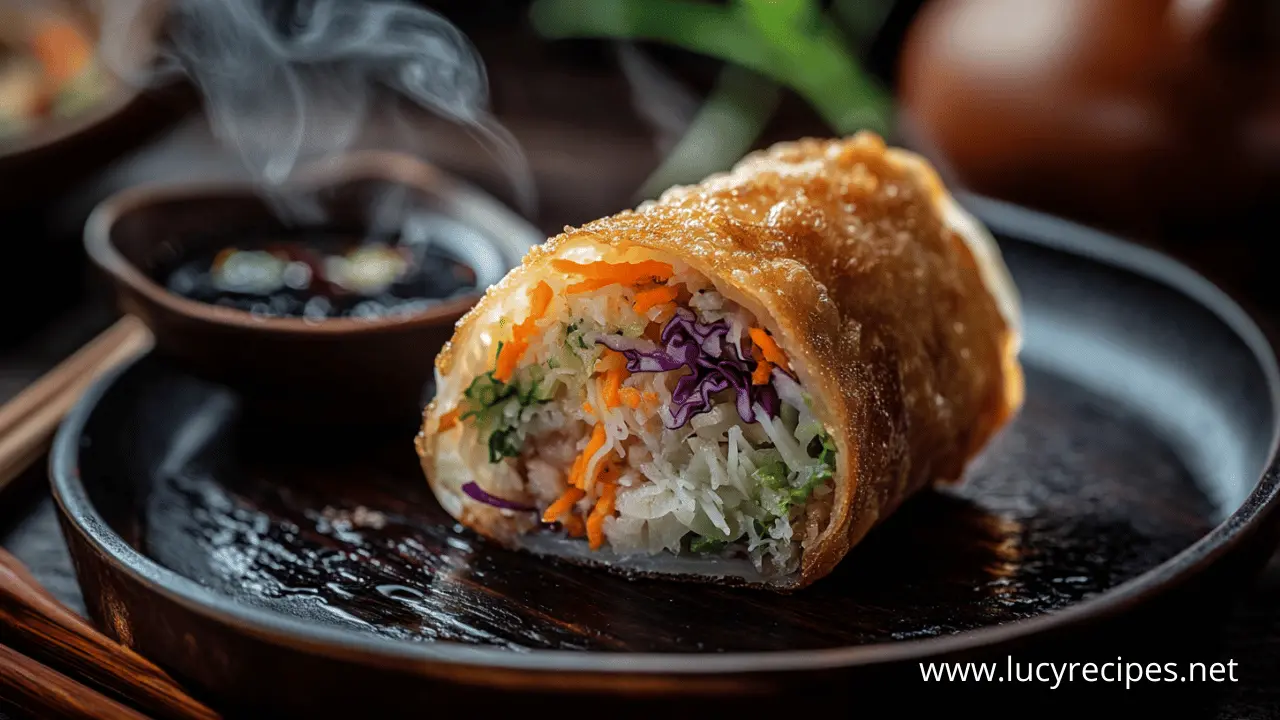Introduction
Egg rolls are a popular appetizer in many Asian cuisines, especially in American-Chinese restaurants. Crispy, golden brown, and often filled with a savory mix of vegetables, meat, and seasonings, they’re undeniably delicious. But when it comes to nutrition, you might wonder—are egg rolls junk food? The answer depends on several factors, including ingredients, preparation methods, and portion size. In this article, we’ll break down what defines junk food and whether egg rolls fit into that category.
What Defines Junk Food?
Junk food generally refers to foods that are high in calories, unhealthy fats, refined carbs, and added sugars while offering little nutritional value. These foods are often processed, deep-fried, or loaded with artificial additives, making them more about taste and convenience than health. Common examples include chips, soda, fast food, and sugary snacks. However, the line between junk food and a well-balanced meal isn’t always clear-cut—some foods can be both tasty and nutritious depending on how they’re made.
What Are Egg Rolls?
Egg rolls are deep-fried appetizers typically made with a wheat flour wrapper filled with shredded cabbage, carrots, onions, and protein like pork, chicken, or shrimp. The filling is often seasoned with soy sauce, garlic, and other savory flavors before being tightly wrapped and fried until crispy. While the filling itself can be nutritious, the frying process adds extra calories and fat, which raises concerns about whether egg rolls fall into the junk food category. Additionally, commercially made egg rolls often contain preservatives and additives, making them less healthy than homemade versions.
So, are egg rolls junk food or not? It depends on how they’re prepared and consumed. Keep reading to explore healthier alternatives and ways to enjoy egg rolls without the guilt!
Table of Contents
Nutritional Profile of Egg Rolls
Egg rolls are a beloved appetizer, but their nutritional value can vary depending on the ingredients and preparation methods. To determine whether they qualify as junk food, let’s break down their calorie content, macronutrients, and the difference between store-bought and homemade versions.
Calories and Macronutrients
A typical fried egg roll (about 120–150 grams) contains approximately 200–300 calories, with most of those calories coming from carbohydrates and fats. Here’s a general macronutrient breakdown:
- Carbohydrates: 20–30 grams (mainly from the wheat wrapper)
- Protein: 5–10 grams (from meat or tofu fillings)
- Fat: 10–15 grams (mostly from deep frying)
Since egg rolls are deep-fried, they tend to be high in saturated fat and may contain trans fats, depending on the frying oil. The frying process also significantly increases calorie content compared to fresh spring rolls or baked alternatives..
Common Ingredients in Egg Rolls
Egg rolls typically include a combination of vegetables, protein, and seasonings, wrapped in a wheat-based shell. Common ingredients include:
- Vegetables: Shredded cabbage, carrots, onions, and sometimes bean sprouts
- Protein: Ground pork, chicken, shrimp, tofu, or beef
- Seasonings: Soy sauce, garlic, ginger, and sesame oil for flavor
- Wrapper: Wheat-based dough, which becomes crispy when fried
- Cooking Oil: Often vegetable or canola oil, used for deep frying
While the vegetables and protein in egg rolls provide fiber and essential nutrients, the fried wrapper and added oils contribute to higher fat and calorie content.
Store-Bought vs. Homemade Egg Rolls
The nutritional quality of egg rolls depends largely on where and how they are made:
- Store-Bought or Restaurant Egg Rolls: Often deep-fried in highly processed oils, they may contain preservatives, MSG, and added sodium. Pre-packaged frozen egg rolls can also be loaded with artificial ingredients and excessive fat.
- Homemade Egg Rolls: Allow for healthier ingredient choices, including leaner meats, more vegetables, and alternative cooking methods like baking or air frying, which significantly reduce fat content.
Egg rolls can be considered junk food when deep-fried and loaded with processed ingredients. However, homemade or baked versions with fresh ingredients can be a much healthier option. If you’re looking to enjoy egg rolls without the guilt, consider making them at home with whole ingredients and lighter cooking methods!
Are Egg Rolls Healthy?

Egg rolls are a flavorful and satisfying dish, but their healthiness depends on how they’re made and consumed. While they do offer some nutritional benefits, they also come with drawbacks—especially when deep-fried or store-bought. Let’s break down the pros and cons to see if egg rolls fit into a balanced diet.
Pros of Eating Egg Rolls
- Nutrient-Rich Ingredients: Many egg rolls contain a mix of cabbage, carrots, onions, and other vegetables, which provide essential vitamins, fiber, and antioxidants.
- Good Source of Protein: Egg rolls that include lean meats like chicken, shrimp, or tofu offer a protein boost, which helps with muscle repair and satiety.
- Customizable for Healthier Choices: Making homemade egg rolls allows you to control ingredients, reduce sodium, and opt for baking or air frying instead of deep frying.
Cons of Eating Egg Rolls
- High in Calories and Fat: Traditional deep-fried egg rolls contain 200–300 calories and 10–15 grams of fat per roll, with much of it coming from frying oil.
- Excess Sodium and Additives: Store-bought or restaurant egg rolls often include high amounts of sodium, preservatives, and flavor enhancers like MSG, which can contribute to health issues like high blood pressure.
- Refined Carbs: The wheat-based wrapper provides simple carbohydrates with little fiber, which can cause blood sugar spikes, especially when paired with sweet dipping sauces.
Comparing Egg Rolls to Similar Foods
If you’re trying to make a healthier choice, here’s how egg rolls compare to other similar foods:
| Food Item | Calories (per serving) | Fat | Healthier Alternative? |
|---|---|---|---|
| Fried Egg Roll | 200–300 | High | Air-fried or baked egg rolls |
| Fresh Spring Roll | 150–200 | Low | Yes, rice paper wraps and no frying |
| Dumplings | 40–80 (per piece) | Medium | Steamed dumplings are a better option |
| Fried Wontons | 150–200 | High | Steamed or baked wontons |
Egg rolls can be both nutritious and indulgent, depending on how they’re prepared. If eaten in moderation, especially with lighter cooking methods, they can fit into a balanced diet. However, deep-fried versions with processed ingredients lean more toward junk food than a healthy meal option. To enjoy egg rolls without guilt, opt for homemade, baked, or air-fried versions with plenty of veggies and lean protein!
Cultural and Culinary Context
Egg rolls are a staple in many Asian cuisines, particularly in Chinese-American restaurants, but their origins and preparation methods vary across different regions. To understand whether egg rolls are considered junk food, it’s important to explore their history and how they are made worldwide.
Origin of Egg Rolls
The exact origins of egg rolls are debated, but they are believed to have evolved from Chinese spring rolls, which date back to ancient China. Unlike spring rolls, which have thinner, rice-based wrappers and are often served fresh or lightly fried, egg rolls have a thicker, wheat-based wrapper and are traditionally deep-fried.
The modern egg roll, as known in the U.S., likely emerged in the early 20th century as part of Chinese-American cuisine. Chinese immigrants adapted their traditional recipes to appeal to Western tastes, leading to the creation of the crispy, savory egg rolls commonly found in American Chinese restaurants today.
How Egg Rolls Are Prepared in Different Regions
Egg rolls vary significantly depending on the region and cultural influences:
- Chinese-American Egg Rolls: Typically deep-fried with a wheat-based wrapper and filled with cabbage, carrots, and ground pork or chicken. Often served with sweet and sour sauce or duck sauce.
- Vietnamese Chả Giò: Made with rice paper wrappers and filled with ground pork, shrimp, mushrooms, and glass noodles. These are usually fried but lighter than traditional egg rolls.
- Filipino Lumpia: A thinner, crispier version of the egg roll, often filled with minced pork, shrimp, or vegetables and deep-fried to perfection. Some variations, like lumpiang sariwa, are served fresh with a peanut sauce.
- Thai Poh Pia Tod: Similar to egg rolls but often lighter and served with spicy chili sauce or peanut dipping sauce.
- Korean Kimmari: A unique twist that involves rolling seaweed around glass noodles before deep-frying, creating a crispy texture similar to egg rolls.
Egg rolls are a versatile dish with deep cultural roots, and their nutritional profile varies depending on preparation. While deep-fried versions are higher in fat and calories, many regions offer healthier variations with lighter fillings and cooking methods. Whether egg rolls qualify as junk food depends on how they’re made and consumed—homemade or baked versions with fresh ingredients are a healthier alternative to their deep-fried counterparts!
Egg Rolls in a Balanced Diet

While egg rolls can be an indulgent treat, they can also fit into a well-balanced diet when consumed mindfully. Understanding portion control, healthier alternatives, and the best sides to pair them with can help you enjoy egg rolls without compromising your nutrition goals.
Moderation and Portion Control
Eating egg rolls in moderation is key to keeping them from tipping into junk food territory. Since traditional egg rolls are deep-fried and high in calories, consider these portion control tips:
- Limit your intake: Stick to one or two egg rolls per meal instead of making them the main course.
- Balance with other foods: Pair them with lean proteins, fiber-rich vegetables, and whole grains to avoid excessive fat and carb intake.
- Mind the dipping sauces: Many popular sauces, like sweet and sour or duck sauce, are high in sugar and sodium. Opt for low-sodium soy sauce, chili sauce, or a light vinegar-based dip instead.
Healthier Alternatives to Traditional Egg Rolls
If you’re looking for a lighter way to enjoy egg rolls, consider these healthier variations:
- Baked Egg Rolls: Instead of deep-frying, brush the rolls with a small amount of oil and bake at 375°F (190°C) for 20–25 minutes until crispy.
- Air-Fried Egg Rolls: Using an air fryer significantly reduces fat content while keeping the wrapper crispy. Cook at 375°F (190°C) for about 10 minutes, flipping halfway.
- Spring Rolls: Fresh spring rolls wrapped in rice paper and filled with lean protein and fresh veggies are a low-calorie alternative.
- Lettuce Wraps: Skip the wrapper altogether and enjoy the egg roll filling in crisp lettuce cups for a low-carb option.
For more ideas on customizing fillings for egg rolls, check out What Should I Put in a Roll?.
Pairing Egg Rolls with Nutritious Sides
Pairing egg rolls with nutrient-dense sides can help balance the meal and make it more wholesome. Here are some great options:
- Steamed or Stir-Fried Vegetables: Broccoli, bok choy, or bell peppers add fiber, vitamins, and minerals.
- Brown Rice or Quinoa: A whole grain option provides complex carbohydrates and keeps you full longer.
- Miso Soup or Egg Drop Soup: Light, broth-based soups can complement egg rolls without adding excess calories.
- Fresh Salad: A side salad with a light vinaigrette can provide a refreshing contrast to the crispy texture of egg rolls.
Egg rolls don’t have to be classified as junk food if eaten in moderation and prepared using healthier methods. By choosing baked or air-fried versions, watching portion sizes, and pairing them with nutritious sides, you can enjoy egg rolls as part of a balanced diet without guilt!
FAQs
Are Egg Rolls Good for Weight Loss?
Egg rolls are not typically ideal for weight loss due to their high calorie and fat content, especially when deep-fried. A single fried egg roll can contain 200–300 calories and 10–15 grams of fat, which can add up quickly. However, baked or air-fried versions with lean protein and extra vegetables can be a healthier option. If you’re watching your weight, limit portions and pair egg rolls with low-calorie, nutrient-dense sides like steamed vegetables or salad.
Can Egg Rolls Be Made Gluten-Free?
Yes! Traditional egg roll wrappers are made from wheat flour, which contains gluten, but there are gluten-free alternatives available:
- Use rice paper wrappers (like Vietnamese spring rolls) instead of wheat-based ones.
- Look for gluten-free egg roll wrappers at specialty grocery stores.
- Make a deconstructed egg roll bowl, using all the flavorful fillings without the wrapper.
- Ensure all sauces, such as soy sauce, are labeled gluten-free or substitute with tamari or coconut aminos.
What Oils Are Best for Frying Egg Rolls?
If you choose to fry egg rolls, selecting the right oil can make a difference in taste and health. The best options are:
- Peanut oil – High smoke point and adds a rich flavor.
- Avocado oil – A healthier alternative with a high smoke point.
- Canola oil – A neutral-flavored, budget-friendly option.
- Vegetable oil – Common for frying, but can be less healthy due to its high omega-6 content.
To minimize excess oil absorption, fry at 350–375°F (175–190°C) and drain on paper towels after frying.
How Long Can Egg Rolls Be Stored?
Proper storage is key to keeping egg rolls fresh. Here’s a quick guide:
- Refrigerated (Cooked): Store in an airtight container for up to 3–4 days. Reheat in an oven or air fryer for crispiness.
- Frozen (Uncooked): Place egg rolls in a single layer on a baking sheet, freeze until solid, then transfer to a freezer bag for up to 3 months.
- Frozen (Cooked): Can last up to 2 months when wrapped tightly and stored in an airtight container.
Avoid microwaving when reheating, as it can make egg rolls soggy. Instead, bake or air-fry them for the best texture.
Are There Vegan Egg Rolls?
Yes! Many egg rolls can be made vegan by replacing meat with plant-based ingredients, such as:
- Tofu or tempeh for protein.
- Mushrooms, cabbage, carrots, and bean sprouts for texture and nutrients.
- Soy sauce, garlic, and ginger for flavor.
- Use vegan egg roll wrappers (some traditional wrappers contain egg).
For an even healthier option, bake or air-fry them instead of deep-frying.
Are Frozen Egg Rolls Healthy?
Frozen egg rolls vary in healthiness depending on the ingredients and preparation. Many store-bought frozen egg rolls contain:
- High sodium levels (over 500mg per roll in some brands).
- Preservatives and additives to extend shelf life.
- Excessive saturated fats from frying and low-quality oils.
If choosing frozen egg rolls, check the ingredient list and nutrition label for better options. Opt for brands that use whole ingredients, less sodium, and no artificial additives. Alternatively, make your own and freeze them for a healthier homemade option!
Conclusion
Final Thoughts on Egg Rolls and Health
So, is an egg roll junk food or not? The answer depends on how it’s made, how often it’s consumed, and what it’s paired with. Traditional deep-fried egg rolls tend to fall into the junk food category due to their high calorie, fat, and sodium content. However, when made with wholesome ingredients, lean protein, and lighter cooking methods like baking or air frying, egg rolls can be part of a balanced diet.
If you enjoy egg rolls, consider making them at home for a healthier alternative by:
✔ Using more vegetables and lean proteins for better nutrition.
✔ Choosing whole wheat or rice paper wrappers for a lighter option.
✔ Baking or air-frying instead of deep-frying to cut excess oil.
✔ Limiting processed sauces that are high in sugar and sodium.
At the end of the day, egg rolls can be an occasional indulgence or a nutritious meal depending on how they’re prepared. Whether you stick to homemade versions or opt for healthier store-bought options, mindful choices can help you enjoy this crispy favorite without the guilt!
For a delicious homemade option, try this Crispy Breakfast Egg Rolls Recipe.

